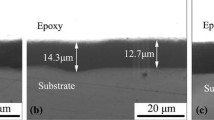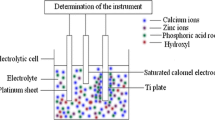Abstract
To improve corrosion resistance of metallic implant surfaces, Rex-734 alloy was coated with two different bio-ceramics; single-Hydroxyapatite (HA), double-HA/Zirconia(Zr) and double-Bioglass (BG)/Zr by using sol–gel method. Porous surface morphologies at low crack density were obtained after coating and sintering processes. Corrosion characteristics of coatings were determined by Open circuit potential and Potentiodynamic polarization measurements during corrosion tests. Hardness and adhesion strength of coating layers were measured and their surface morphologies before and after corrosion were characterized by scanning electron microscope (SEM), XRD and EDX. Through the SEM analysis, it was observed that corrosion caused degradation and sphere-like formations appeared with dimples on the coated surfaces. The coated substrates that exhibit high crack density, the corrosion was more effective by disturbing and transmitting through the coating layer, produced CrO3 and Cr3O8 oxide formation. It was found that the addition of Zr provided an increase in adhesion strength and corrosion resistance of the coatings. However, BG/Zr coatings had lower adhesion strength than the HA/Zr coatings, but showed higher corrosion resistance.







Similar content being viewed by others

References
Singh V, Marchev K, Cooper CV, Meletis EI. Intensified plasma-assisted nitriding of AISI 316L stainless steel. Surf Coat Technol. 2002;160:249–58.
Ratner BD, Hoffman AS, Schoen FJ, Lemons JE. Biomaterial science: an introduction to material in medicine. San Diego: Academic Press; 1996.
Sumita M. Present status and future trend of metallic materials used in orthopedics. Orthop. Surg. 1997;48:927–34.
Placko HE, Brown SA, Payer JH. Release of cobalt and nickel from a new total finger joint prosthesis made of vitallium. J Biomed Mater Res. 1983;17:655–68.
Tiwari SK, Mishra T, Gunjan MK, Bhattacharyya AS, Singh TB, Singh R. Development and characterization of sol–gel silica–alumina composite coatings on AISI 316L for implant applications. Surf Coat Technol. 2007;201:7582–8.
Liu DM, Yang Q, Troczynski T. Sol–gel hydroxyapatite coatings on stainless steel substrates. Biomaterials. 2002;23:691–8.
Balamurugan A, Balossier G, Kannan S, Rajeswari S. Elaboration of sol-gel derived apatite films on surgical grade stainless steel for biomedical applications. Mater Lett. 2006;60:2288–93.
Fathi MH, Mohammadi AD. Preparation and characterization of sol–gel bioactive glass coating for improvement of biocompatibility of human body implant. Mater Sci Eng A. 2008;474:128–33.
Salehi S, Fathi MH. Fabrication and characterization of sol-gel derived Hydroxyapatite/Zirconia composite nanopowders with various Yttria contents. Ceram Int. 2010;36:1659–67.
Balamurugan A, Balossier G, Kannan S, Michel J, Faure J, Rajeswari S. Electrochemical and structural characterisation of zirconia reinforced hydroxyapatite bioceramic sol–gel coatings on surgical grade 316L SS for biomedical applications. Ceram Int. 2007;33:605–14.
Garcia C, Cere S, Duran A. Bioactive coatings prepared by sol–gel on stainless steel 316L. J Non-Cryst Solids. 2004;348:218–24.
Kannan S, Balamurugan A, Rajeswari S. H2SO4 as a passivating medium on the localised corrosion resistance of surgical 316L SS metallic implant and its effect on hydroxyapatite coatings. Electrochim Acta. 2004;49:2395–403.
Aksakal B, Dikici B, Sonmez S. Corrosion protection of AA6061-T4 alloy by sol–gel derived micro and nano-scale hydroxyapatite (HA) Coating. J Sci Technol. 2012;12:2813–8.
Kim HW, Koh YH, Li LH, Lee S, Kim HE. Hydroxyapatite coating on titanium substrate with titania buffer layer processed by sol–gel method. Biomaterials. 2004;25:2533–8.
Montenero A, Gnappi G, Ferrari F, Cesari M, Salvioli E, Mattogno L, et al. Sol–gel derived hydroxyapatite coatings on titanium substrate. J Mater Sci. 2000;35:2791–7.
Hsieh MF, Perng LH, Chin TS. Hydroxyapatite coating on Ti6Al4 V alloy using a sol–gel derived precursor. Mater Chem Phys. 2002;74:245–50.
Billotte WG. Ceramic biomaterials. In: Bronzino JD, editor. The biomedical engineering handbook. 2nd ed. Boca Raton: CRC Press LLC; 2000.
Ducheyne P, Radin S, Heughebaert M, Heughebaert JC. Calcium phosphate ceramic coatings on porous titanium: effect of structure and composition on electrophoretic deposition, vacuum sintering and in vitro dissolution. Biomaterials. 1990;11:244–54.
Murugan R, Ramakrishna S. Development of nanocomposites for bone grafting. Compos Sci Technol. 2005;65:2385–406.
Bogdanoviciene I, Beganskiene A, Tonsuaadu K, Glaser J, Meyer HJ, Kareiva A. Calcium hydroxyapatite, Ca10(PO4)6(OH)2 ceramics prepared by aqueus sol–jel processing. Mater Res Bull. 2006;41:1754–62.
Gallardo J, Galliano P, Duran A. Bioactive and protective sol-gel coatings on metals for orthopaedic prostheses. J Sci Technol. 2001;21:65–74.
Guglielmi M. Sol-gel coatings on metals. J Sci Technol. 1997;8:443–9.
Galliano P, De Damborenea JJ, Pascual MJ, Duran A. Sol-gel coatings on 316l steel for clinical application. J Sci Technol. 1998;13:723–7.
Balamurugan A, Balossier G, Kannan S, Michel J, Rajeswari S. In vitro biological, chemical and electrochemical evaluation of titania reinforced hydroxyapatite sol–gel coatings on surgical grade 316L SS. Mater Sci Eng C. 2007;27:162–71.
De Mestral F, Drew RAL. Calcium phosphate glasses and glass-ceramics for medical applications. J of Euro Ceram Soc. 1989;5:47–53.
Rincon JM, Callejas P. Microstructure and microanalysis of bioglasses and glass-ceramics from the MgO-CaO-P2O5-SiO2 system with ZrO2. In: Bioceramics and the human body. Netherlands: Springer; 1992. pp 244–49.
Fathi MH, Salehi M, Mortazavi V, Mousavi SB, Parsapour A. Novel hydroxyapatite/niobium surface coating for endodontic dental implant. Surf Eng. 2006;22:353–8.
Author information
Authors and Affiliations
Corresponding author
Rights and permissions
About this article
Cite this article
Say, Y., Aksakal, B. Effects of hydroxyapatite/Zr and bioglass/Zr coatings on morphology and corrosion behaviour of Rex-734 alloy. J Mater Sci: Mater Med 27, 105 (2016). https://doi.org/10.1007/s10856-016-5716-3
Received:
Accepted:
Published:
DOI: https://doi.org/10.1007/s10856-016-5716-3



